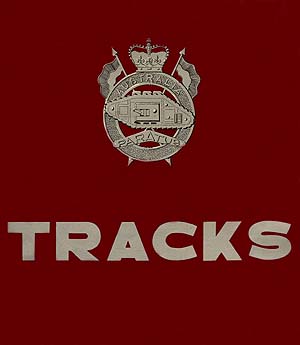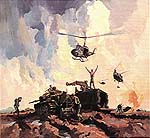Tracks Magazine - August 1955


A couple of decades ago I was travelling through northern NSW and called in to see Archie McDonald, an old 1 Armoured Regiment LAD mate. Archie had kept his copy of the first issue of the Regiment's glossy magazine, Tracks — August 1955. It is this magazine that is re-produced below
Tracks Magazine
Index
Foreword Preface Principles of Employment of Armour Tracks To Tradition Review of Squadron Activities Regimental Headquarters Headquarters Squadron Reconnaissance Troop A Squadron Notes B Squadron Notes Nucleus Squadron Regimental Training Troop Light Aid Detachment, RAEME Signals Troop, RASigsIndex (cont)
Review of Allied Armour Tanks in The Jungle Korean Sidelights Equipments 1954 .. A Royal Occasion On Parade Elevating Gear Officers' Mess Notes Sergeants' Mess Notes In The Realm of Sport It Could be You The Adjutant's Dilemma While Others Sleep [et al] Beauchamps Own Epilogue Free Verse From A Free Thinker

Keep An Open Mind
We belong to an arm of the service which really came into being only as far back as 1916. Since that date the world has seen a tremendous technological advance and this advance is in many respects reflected by the equipment we of the Armoured Corps use today. Had we not in the past been prepared to make use of the devices that science made possible then it would have been doubtful whether the first tank would ever have been manufactured, let alone the modern machines we have got now.
In the past weapons and methods of making war have changed gradually as scientific advances have been made. The introduction of gunpowder into the Western world spelt the doom of the knight in armour, as surely as the modern machine guns and artillery swept the cavalryman of the nineteenth century from the twentieth century battlefield.
However, if we look carefully we shall usually be able to observe that there is a very considerable time lag between the time when a weapon or a method of warfare becomes outmoded, and the time when that method or weapon is finally discarded. I imagine that the lance had ceased to be particularly useful as a weapon of war by the early nineteenth century. And yet as recently as 1939, I remember during cavalry training being seriously coached as to what I should do if a lancer came at me from the left front! When I pointed out to the instructor that it seemed to be a rather unlikely contingency, I was, of course, very properly put in my place. I am now in the very happy position of being able to let any of you into the secret, should you be interested!
Not only are we very loath to discard things, but we tend also to be very slow to accept any-thing new. The early protagonists of Armour envisaged that not only should our fighting vehicles move on tracks, but so should our supply vehicles. The Second World War proved that these men were right and few people would now disagree. However, if you have any illusions about how much progress that idea has made as at this date then I suggest, when you have nothing better to do, you take a walk up to our transport lines sometime. And yet for all that, the idea will eventually be converted to a reality.
The idea that took longest to die in this modern age was the idea of the supremacy of the horse and the mounted soldier. I doubt whether the idea is thoroughly dead yet, as the tankman's way of waging war is sometimes boxed in by those limitations that the horseman accepted. We, therefore, seem chary about accepting the fact that armour
can fight a pitched battle primarily on its own, but feel that it must always be the helper and the exploiter of other people's successes. I would warn you that there are certain powerful nations who do not accept this latter view.
Now it is all very well for us to look down on the horsemen, but are we ourselves above reproach? Do we readily accept new ideas? Do we press hard until our ideas become realities? Do we follow scientific advances and think how they may be put to our use? Do we employ our equipment in accordance with its true characteristics? Are we sure that the true characteristics of our equipment are in line with our own real requirements?
I feel that the true answers to these questions are perhaps a little disturbing.
There are certain developments which we should think about today. The atomic projectile is bound to have quite marked effect on battlefield tactics. We, above all the arms, enjoy a relative degree of immunity on the atomic battlefield and, therefore, the proper handling of armoured reserves will be tremendously important.
The helicopter is another development we should watch. It has great possibilities as a reconnaissance vehicle, a command vehicle and a transport vehicle. Our great roadbound supply columns have always been a great problem and this problem can only be solved by dispersion off the road. Movement off the roads is often possible in tracked vehicles, and always possible in helicopters! A combination of both these means of transport would add enormously to the total mobility of an Armoured Regiment.
Whilst we are talking about helicopters, it is interesting to note that it is possible for large helicopters to lift the equivalent in weight to a tank. It may well be possible therefore to design a grapple which would lift a tank over a minefield, a river, a patch of bad going or, for that matter, a mountain range!
If you go into the matter you will find that the possibilities for development are tremendous and that they apply universally from designing a better means of refuelling than the humble "jerrican" to designing a sort of heavily armed and armoured flying machine that will displace the conventional tank altogether. We must welcome these developments and do our best to provide the ideas that may make these developments possible. If somebody produces a new piece of equipment for us to try, then we must not damn it simply because it differs radically from some trusted and tried piece of equipment with which we are familiar. Our criticisms must be logical and constructive and not be based on prejudice or instinctive conservatism.
"And when the mind is quickened out of doubt, The organs, though defunct and dead before, Break up their drowsy grave and newly move, With tasted Slough and fresh legerity."


